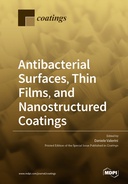Explore

Antibacterial Surfaces, Thin Films, and Nanostructured Coatings
0 Ungluers have
Faved this Work
Login to Fave
Creating antibacterial surfaces is the primary approach in preventing the occurrence and diffusion of clinical infections and foodborne diseases as well as in contrasting the propagation of pandemics in everyday life. Proper surface engineering can inhibit microorganism spread and biofilm formation, can contrast antimicrobial resistance (AMR), and can avoid cross-contamination from a contaminated surface to another and eventually to humans. For these reasons, antibacterial surfaces play a key role in many applications, ranging from biomedicine to food and beverage materials, textiles, and objects with frequent human contact. The incorporation of antimicrobial agents within a surface or their addition onto a surface are very effective strategies to achieve this aim and to properly modify many other surface properties at the same time. In this framework, this Special Issue collects research studying several materials and methods related to the antibacterial properties of surfaces for different applications and discussions about the environmental and human-safety aspects.
This book is included in DOAB.
Why read this book? Have your say.
You must be logged in to comment.
Rights Information
Are you the author or publisher of this work? If so, you can claim it as yours by registering as an Unglue.it rights holder.Downloads
This work has been downloaded 100 times via unglue.it ebook links.
- 100 - pdf (CC BY) at Unglue.it.
Keywords
- aluminum-doped zinc oxide (AZO)
- antibacterial
- antibacterial coating
- antibiotic resistance
- antibiotics
- antifouling
- antimicrobial
- antimicrobial coatings
- antimicrobial peptide
- antiviral
- aPDT
- atomic force microscopy (AFM)
- bacterial attachment
- Biofilm
- Biomaterials
- biomedical
- Biomedical applications
- bioremediation
- BODIPY
- C. violaceum
- Cellulose
- composite
- copolymers
- Cytotoxicity
- Drug delivery
- drug loading
- electrodeposition
- electrospinning
- foams
- food packaging
- functionalization
- Graphene
- halloysite nanotubes
- Health
- hybrid composites
- LL 37
- Magainin
- Mechanical properties
- metal ions
- metal nanoparticles
- micelles
- n/a
- nanocomposite
- nanofibers
- nanoparticle
- nanosilica
- Parasin
- photodynamic
- plasma polymer
- polycaprolactone (PCL)
- polylactide
- Proteins
- Quorum Sensing
- RF sputtering (RFS)
- ring opening polymerization
- S. marcescens
- Silver
- silver nanoparticles
- sputtering
- supersonic cluster beam deposition (SCBD)
- supramolecular systems
- Technology, engineering, agriculture
- Technology: general issues
- thin film
- titanium dioxide
- titanium implants
- Virulence
- xanthan gum
- Zinc
- Zinc oxide
Links
DOI: 10.3390/books978-3-0365-1631-8Editions

